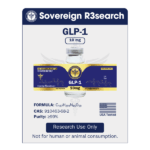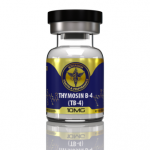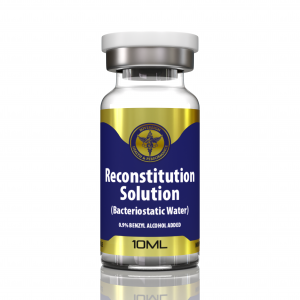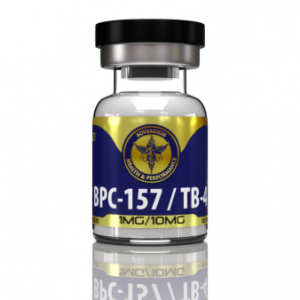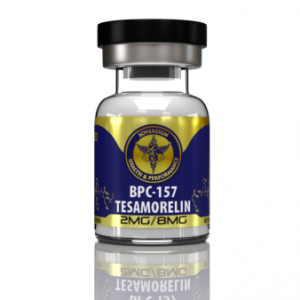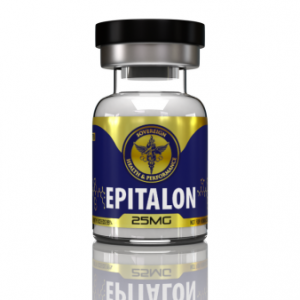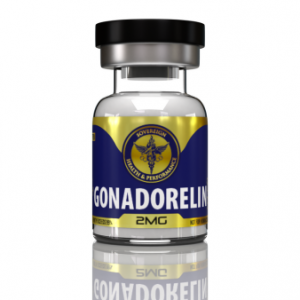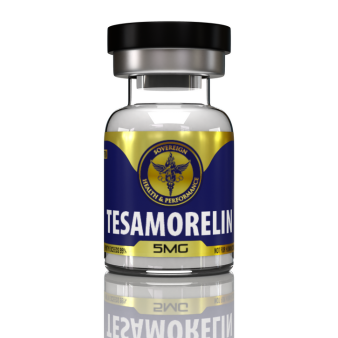
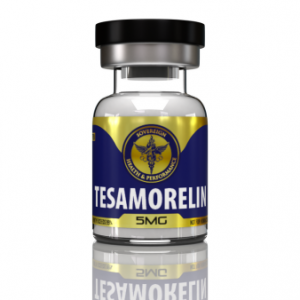
Tesamorelin
$69.00
Research Only Purposes
- Description
- Quality Documentation
- Additional information
Description
💉 What is Tesamorelin
Tesamorelin is a synthetic peptide analog of Growth Hormone–Releasing Hormone (GHRH 1–44), engineered for longer biological activity. Its N-terminal trans-3-hexenoyl modification stabilizes the molecule and extends its half-life, allowing for sustained action.
Tesamorelin binds to GHRH receptors in the anterior pituitary gland, stimulating the natural, pulsatile release of growth hormone (GH). This rise in GH subsequently increases circulating insulin-like growth factor-1 (IGF-1), which mediates many of GH’s anabolic and metabolic effects.
Because Tesamorelin promotes the body’s own GH release rather than introducing GH directly, it is widely studied for its effects on body composition, lipid metabolism, mitochondrial function, and metabolic regulation—while maintaining a physiologic GH rhythm.
🔬 Molecular Structure

Sequence (Single Letter): trans-3-hexenoyl–Tyr-Ala-Asp-Ala-Ile-Phe-Thr-Asn-Ser-Tyr-Arg-Lys-Val-Leu-Gly-Gln-Leu-Ser-Ala-Arg-Lys-Leu-Leu-Gln-Asp-Ile-Met-Ser-Arg-Gln-Gln-Gly-Glu-Ser-Asn-Gln-Glu-Arg-Gly-Ala-Arg-Ala-Arg-Leu
Length: 44 amino acids (GHRH analog)
Molecular Formula: C₂₂₃H₃₇₀N₇₂O₆₉S
Molecular Weight: 5195.9 g/mol
PubChem CID: 44147413
CAS Number: 901758-09-6
Source: PubChem
🔬 Tesamorelin: Key Research Areas and Potential Benefits
1. Visceral Fat and Body Composition
Tesamorelin is most well known for its effect on visceral adipose tissue (VAT), the deep fat surrounding internal organs. It is FDA-approved for HIV-associated lipodystrophy, where it has been shown to significantly reduce VAT through GH-mediated lipolysis and fat redistribution—without substantial loss of subcutaneous fat.
In research models, these findings make Tesamorelin an important compound for studying metabolic flexibility, lipid mobilization, and body composition regulation.
Reference:
Falutz J, Allas S, Blot K, et al. Effects of tesamorelin, a growth hormone–releasing factor analog, on visceral adipose tissue in HIV-infected patients with abdominal fat accumulation: a randomized placebo-controlled trial. J Clin Endocrinol Metab. 2007;92(9):3584-3591. doi:10.1210/jc.2007-0440
2. Lipid Metabolism and Cardiovascular Markers
Tesamorelin has been associated with improved lipid profiles, including reduced triglycerides and increased high-density lipoprotein (HDL) cholesterol. These effects appear secondary to VAT reduction and improved GH/IGF-1 signaling, making it relevant to models of cardiometabolic risk reduction rather than direct lipid therapy.
Reference:
Dhillon S. Tesamorelin: in HIV-associated lipodystrophy. Drugs. 2011;71(14):1851-1859. doi:10.2165/11207560-000000000-00000
3. Cognitive and Neurological Function
Recent research has explored Tesamorelin’s effects on executive function and memory. These cognitive outcomes may relate to GH and IGF-1’s influence on neuronal survival, plasticity, and metabolic efficiency. Studies in HIV populations have reported improvements in cognitive testing, suggesting Tesamorelin may serve as a research tool for understanding GH/IGF-1-mediated neuroprotection.
Reference:
Geffken GR, Chanson P, Riddle RR, et al. Growth hormone–releasing hormone analog tesamorelin improves cognitive function in HIV-infected patients. AIDS. 2021;35(10):1511-1518. doi:10.1097/QAD.0000000000002895
4. Muscle Anabolism
By raising endogenous GH and IGF-1, Tesamorelin supports muscle protein synthesis, nitrogen retention, and recovery. It has been used in models of sarcopenia (age-related muscle loss) and anabolic resistance to assess how GH axis activation affects muscle mass and function.
Reference:
Stanley TL, Grinspoon SK, Makimura H, et al. Tesamorelin reduces visceral fat and improves body composition in HIV-infected men with low GH and IGF-1. J Clin Endocrinol Metab. 2017;102(9):3405-3415. doi:10.1210/jc.2017-00688
5. Skin Structure and Elasticity
Because GH stimulates collagen production and dermal thickening, Tesamorelin’s GH-releasing properties are of interest in studies of skin aging and dermal regeneration. While direct Tesamorelin data remain limited, related GH research shows enhanced skin elasticity and structural protein synthesis.
Reference:
Rudman D, Feller AG, Nagraj HS, et al. Effects of human growth hormone in men over 60 years old. N Engl J Med. 1990;323(1):1-6. doi:10.1056/NEJM199007053230101
6. Bone Density and Structural Integrity
Through IGF-1 signaling, Tesamorelin may stimulate osteoblast differentiation and bone remodeling. Clinical studies have shown increased bone mineral density in HIV-related lipodystrophy, suggesting a potential model for age-related osteoporosis research.
Reference:
Stanley TL, Klibanski A, Sinha A, et al. Tesamorelin is associated with improved bone mineral density in HIV-infected adults with lipodystrophy. J Clin Endocrinol Metab. 2015;100(12):4502-4510. doi:10.1210/jc.2015-2375
7. Energy Metabolism
Tesamorelin has been observed to enhance mitochondrial function and basal metabolic rate through GH-driven effects on oxidative metabolism. Research models focus on ATP production, mitochondrial efficiency, and glucose utilization, linking Tesamorelin to improved metabolic energy output under stress or caloric restriction.
Reference:
Lo J, Shikuma CM, Makimura H, et al. Effects of tesamorelin on energy expenditure and mitochondrial function in HIV-infected patients with lipodystrophy. Endocr Pract. 2017;23(4):447-456. doi:10.4158/EP161582.OR
8. Inflammatory Modulation
Tesamorelin has demonstrated effects on systemic inflammatory markers, including reductions in high-sensitivity C-reactive protein (hs-CRP) and cytokines such as IL-6. These observations have led to studies exploring Tesamorelin’s potential in metabolic syndrome and chronic low-grade inflammation models.
Reference:
Stanley TL, Koutkia P, Sinha A, et al. Effects of tesamorelin on hs-CRP and other inflammatory markers in HIV-infected patients with excess visceral adiposity. J Clin Endocrinol Metab. 2014;99(11):4119-4127. doi:10.1210/jc.2014-2568
9. Sleep and Circadian Biology
GH secretion naturally peaks during slow-wave (deep) sleep. By restoring physiologic GH rhythms, Tesamorelin may influence sleep architecture and recovery processes. While this relationship is drawn primarily from GH physiology, it remains a subject of ongoing investigation.
Reference:
Van Cauter E, Leproult R, Plat L. Growth hormone secretion during sleep. J Clin Invest. 1997;100(5 Suppl):S32-S35. doi:10.1172/JCI119283
10. Immune System Research
Growth hormone and IGF-1 affect immune homeostasis, including thymic size, lymphocyte development, and cytokine balance. Tesamorelin is being evaluated in chronic disease models for its potential to modulate immune function through endocrine-immune signaling pathways.
Reference:
Kaiser PK, Falutz J, Carter GM, et al. Effects of tesamorelin on CD4 count in HIV-infected patients with lipodystrophy. J Acquir Immune Defic Syndr. 2008;49(3):328-333. doi:10.1097/QAI.0b013e31818a6378
🚀 Future Areas of Research and Clinical Focus
-
Non-HIV Metabolic Syndrome: Studies are exploring Tesamorelin’s ability to reduce VAT and improve lipid metabolism in general metabolic syndrome and non-alcoholic fatty liver disease (NAFLD) models.
-
Cognitive Decline: Research continues to assess whether Tesamorelin’s GH/IGF-1 pathway activation can support neurocognitive resilience in aging populations.
-
Sarcopenia and Muscle Preservation: Clinical work is expanding to evaluate Tesamorelin as a tool for studying muscle anabolism, strength, and repair in older adults and those with chronic disease–related wasting.
✳️ Summary
Tesamorelin is a long-acting analog of GHRH that enables researchers to study endogenous growth hormone regulation and its systemic effects on metabolism, body composition, and cellular health. Its unique pharmacological profile—activating GH in natural pulses—makes it an important model compound for investigating lipid metabolism, cognitive function, and age-related physiologic decline.
In plain summary: Tesamorelin helps scientists explore how restoring natural GH rhythms can influence energy balance, tissue regeneration, and metabolic resilience over time.
Additional information
| CAS | 804475-66-9 |
|---|---|
| MG | 5 |
| Brand | Sovereign Health and Performance |


